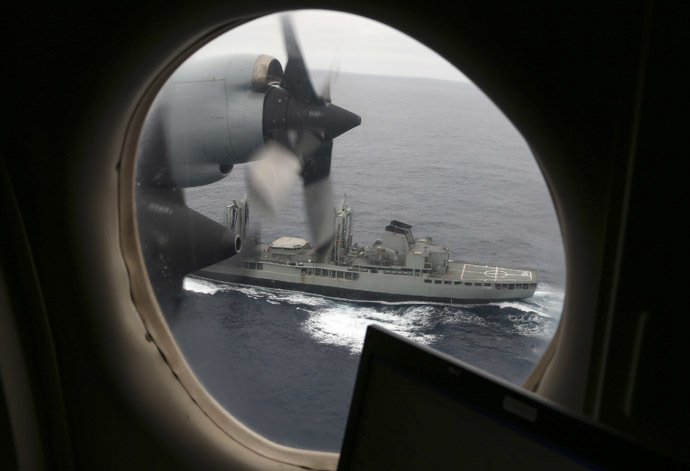On Beijing’s bad side: Malaysia faces political costs of MH370 disaster

The puzzling disappearance of Malaysia Airlines flight MH370 has seriously harmed Malaysia’s image abroad, and the government’s handling of the crisis has garnered criticism from domestic opposition parties and key ally, China.
As the search for the missing flight MH370 enters its third week, hopes are high that the large objects spotted in the inaccessible southern Indian Ocean might be related to the aircraft. Enormous resources have gone toward an extensive multinational search and rescue effort, said to be the largest in history, and a plentiful array of theories and speculation have been considered in the absence of hard facts.
The case of MH370 – the longest civil aircraft disappearance in modern history – is unprecedented, and aviation experts will likely be trying to put the pieces together for the next several months, if not years. It should be noted that any government would be ill prepared to deal with such an unusual disaster scenario.
For Malaysia – a country that has rarely faced disasters, terrorism or emergency situations – the shortcomings of the government’s response have been magnified by a lack of experience. Malaysia’s leaders have been thrust into a very unenviable position in the global spotlight, while the contradictory statements of government officials, a delayed release of information, and critical inaction of Malaysia’s military in responding to the aircraft as it flew wildly off course have all compounded the frustrations of the relatives of those onboard.
Rising mistrust
Diplomatic relations between Beijing and Kuala Lumpur have been relatively harmonious over the decades, but as some two-thirds of the passengers on the Beijing-bound aircraft were from China, the present crisis has seen China routinely criticize Malaysia’s response by publically cajoling officials into providing more consistent and reliable information.
After the plane disappeared on March 8, in the first days of the crisis regional search and rescue operations were pursuing false leads by erroneously focusing their search in the South China Sea, where the aircraft lost contact less than an hour into the flight.
Although it is believed that the plane’s transponder was deliberately turned off, the plane was seen by Malaysian military radar U-turning back over the peninsula toward the Andaman Sea and the Straits of Malacca. It took a full seven days for Malaysian authorities to release information confirming that the plane had drastically changed direction, and that the plane flew for nearly seven hours after disappearing from air traffic control. The painfully delayed release of information incensed Chinese officials, prompting frequent condemnations of Malaysia in the Chinese state media, which maintained how the lack of timely authoritative information imperiled the lives of passengers by hampering initial rescue attempts.

If the Malaysian response had been different from the onset, perhaps tragedy could have been avoided. Flight MH370 moved through at least three military radar ranges as it traversed the northern area of Peninsular Malaysia, which should have provoked an emergency response from Malaysia’s air force, which could have intercepted the jetliner and possibly guided it toward a safe landing.
It’s possible that Malaysia was reluctant to disclose its radar data because it was disinclined to admit that an unidentified plane had breached air defense when MH370 radically changed directions. Malaysia’s air force claimed that MH370 did not trigger security alarms because the plane’s profile did not indicate it was a hostile craft, and that flight movements were recorded and not observed live. The perception that Malaysian officials appeared uncoordinated and frequently contradicted each other about basic facts prompted Chinese media to scold the poor performance of senior ministers and sharply criticize Malaysia’s system of governance.
An editorial in China’s Global Times newspaper – seen as reflecting the opinions of the leadership in Beijing – criticized Malaysia’s long-held aspiration to become a high-income developed nation by 2020, saying that “judging from its handling of the MH370 incident, Malaysia's modernization will take far longer than this.” Chinese netizens have expressed their solidarity with grieving Chinese families, some of whom are threatening to go on hunger strikes in the absence of Malaysian officials in Beijing to hear their grievances. It hasn't helped that footage has emerged of Malaysian police forcibly removing grieving Chinese relatives as they protested a lack of information at a hotel in Kuala Lumpur. Nearly two million Chinese tourists visited Malaysia in 2013, adding to the $106 billion in bilateral trade between Beijing and Kuala Lumpur. The extent of economic and diplomatic repercussions resulting from the MH370 disaster remains to be seen, but the image of the Malaysian government has been spoiled in the eyes of China’s government and people.
What could have happened to MH370?
The present crisis has led to concerns of competence and rising mistrust of the Malaysian leadership in Beijing and elsewhere, while domestic opposition parties have tried to capitalize on the government’s fumbles. The disappearance of MH370 comes at a time of deep political polarization as support for Malaysia’s entrenched ruling coalition is declining at the polls. Just hours before MH370 took off, judges sentenced opposition leader, Anwar Ibrahim, to five years in jail after overturning his acquittal on charges of engaging in sodomy, thereby preventing him from running in a strategic by-election that could have allowed him to become the chief minister of Selangor, considered Malaysia’s richest and most populous state.
Reports indicate that the flight’s captain, Zaharie Ahmad Shah, was a member of Anwar’s political party and that he actually attended the court hearing prior to reporting to work; he was known to be an obsessive supporter of the opposition and undoubtedly felt like the jailing of the country’s key opposition leader was a grave injustice. Pro-government bloggers that have attempted to spin the story to incriminate the opposition in the flight’s disappearance, while international publications questioned whether Zaharie – who was a highly experienced pilot with deep technical knowledge of the aircraft – would be so incensed by the court verdict that he would crash the plane into the one of the world’s most remote oceans as a political protest.

There is no evidence so far that has emerged to confirm this theory, but such an idea warrants some consideration if Zaharie allegedly attended the trial hours before boarding the aircraft. What has been established is that the aircraft’s movements were consistent with deliberate action by someone on the plane. The jetliner’s transponders were shut off without a mayday call, followed by significant changes in altitude after it lost contact with ground control; the changes in flight trajectory indicates that the plane was continually under the command of a pilot.
Although the transponders were switched off, six routine automated signals from the aircraft’s engine (known as electronic handshakes or "pings") were registered on the Inmarsat satellite network, with the last signal coming at 8:11am on March 9, around the time when the plane ran out of fuel. MH370 dropped to an altitude of around 5,000 feet at times during the flight to avoid commercial radar coverage and had flown low using a technique called "terrain masking" during most of the nearly seven hours it was missing from the radar coverage. It remains to be seen how the aircraft evaded the large US Navy and Air Force presence and numerous listening posts in the seas and airspace surrounding Malaysia as it flew over some of the world's busiest maritime channels.
Using data from the satellite pings, Malaysian authorities expanded the search area to two arcs spanning large distances across Asia. The northern arc passes through or in close proximity to numerous airspaces and highly militarized areas with sophisticated air-defense networks run by the American military; aviation experts posited that the plane might have ended up in the relatively desolate and inaccessible southern arc, where Australian authorities are narrowing their search after possible sightings debris by satellite. It has been confirmed that whoever was responsible for the disappearance of the aircraft was someone with considerable aviation expertise and knowledge of air routes. It is still unknown whether the crew or pilot was operating under duress, but US and Chinese authorities have confirmed that none of the passengers onboard shared any suspicious links to terrorist or extremist groups; there has been no credible attempt from any organization to take responsibility for the disaster. The existing evidence of deliberate action opens the possibility that the aircraft may not be lost at sea, because any pilot skilled enough to avoid military and commercial radar should also be able to land the aircraft.

Another possibility is that MH370 presents an entirely new kind of disaster scenario where security vulnerabilities could have been exploited by hacking into the plane’s in-flight system to infiltrate security software to manipulate the speed, direction and altitude of the aircraft using radio signals, which is technically possible according to security experts. Boeing has acknowledged security vulnerabilities in its model 777-200, -300, and -300ER series airplanes, and previously contacted the US Federal Aviation Administration for permission to change some of the onboard equipment to avoid any such a scenario. If there were any truth to this theory, the degree of sophistication needed to accomplish this task would likely warrant state-sponsorship, and possible motives for doing so would be political, such as to drive a wedge between Malaysia and China at a time when territorial disputes in the South China Sea have led to some countries taking a strong position against Beijing.
While the Malaysian government clearly made mistakes in its handling of the situation, search and investigation efforts have been consistent with international norms and the authorities have done their best to respond to the situation with limited capabilities and experience. Twenty-six nations have taken part in search operations led by Malaysia, and the inability of such a multinational force to produce substantive answers about the aircraft shows that one country shouldn’t unfairly shoulder all the blame in handling an unprecedented air disaster.
UPDATE: Shortly after this article was published, Malaysian Prime Minister Naijb Razak announced that flight MH370 had almost certainly crashed into the southern Indian Ocean with all lives lost. Chinese and Australian search planes have spotted several more objects in the sea, and the multinational investigation will continue until the aircraft’s black box is recovered. The cause of the aircraft’s demise cannot be established until a thorough examination takes place, though newly published reports from anonymous sources close to the investigation believe that Flight MH370 crashed in an apparent suicide mission. Sources claim that theories of electrical fires or mechanical dysfunctions that gained prominence early on cannot be consistent with the calculated and deliberate navigation of the aircraft from the time it lost contact with air traffic controllers. The motive for crashing the plane, if that is what happened, remains unclear.
The statements, views and opinions expressed in this column are solely those of the author and do not necessarily represent those of RT.
The statements, views and opinions expressed in this column are solely those of the author and do not necessarily represent those of RT.












